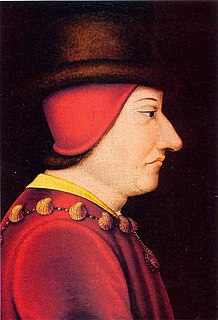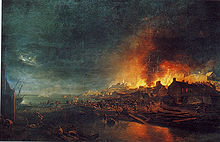
Honoré de Balzac was a French novelist and playwright. The novel sequence La Comédie humaine, which presents a panorama of post-Napoleonic French life, is generally viewed as his magnum opus.

La Comédie humaine is Honoré de Balzac's 1829–48 multi-volume collection of interlinked novels and stories depicting French society in the period of the Restoration (1815–30) and the July Monarchy (1830–48).

Les Chouans is an 1829 novel by French novelist and playwright Honoré de Balzac (1799–1850) and included in the Scènes de la vie militaire section of his novel sequence La Comédie humaine. Set in the French region of Brittany, the novel combines military history with a love story between the aristocratic Marie de Verneuil and the Chouan royalist Alphonse de Montauran. It takes place during the 1799 post-war uprising in Fougères.

La Rabouilleuse is an 1842 novel by Honoré de Balzac, and is one of The Celibates in the series La Comédie humaine. The Black Sheep is the title of the English translation by Donald Adamson published by Penguin Classics. It tells the story of the Bridau family, trying to regain their lost inheritance after a series of mishaps.

La Maison du chat-qui-pelote is a novel by Honoré de Balzac. It is the opening work in the Scènes de la vie privée, which comprises the first volume of Balzac's La Comédie humaine.

Mémoires de deux jeunes mariées is an epistolary novel by the French writer Honoré de Balzac. It was serialized in the French newspaper La Presse in 1841 and published by Furne in 1842 as the first work in the second volume of Balzac's La Comédie humaine. It was dedicated to the French novelist George Sand. The first English translation of the novel appeared in 1902, with a preface by Henry James.

La Bourse is a short story by the French novelist Honoré de Balzac. It was published in 1832 by Mame-Delaunay as one of the Scènes de la vie privée in La Comédie humaine. Later editions of the work were brought out by Béchet in 1835 and by Charpentier in 1839, in both of which La Bourse was placed among the Scènes de la vie parisienne. It was, however, restored to the Scènes de la vie privée when Furne brought out the fourth and final edition in 1842; this heavily revised version of the story appeared as the third work in Volume 1 of La Comédie humaine.

Ursule Mirouët, an often overlooked novel, belongs to Honoré de Balzac’s great series of 94 novels and short stories La Comédie humaine. First published in 1841, it forms part of his Scènes de la vie de province.

Gobseck, an 1830 novella by French author Honoré de Balzac (1799-1850), appears in the Scènes de la vie privée section of his novel sequence La Comédie humaine. Gobseck first appeared in outline form in La Mode in March 1830 under the title l'Usurier, and then in August 1830 in the periodical Le Voleur. The actual novella appeared in a volume published by Mame-Delaunay under the title Les Dangers de l'inconduite. This novella would appear in 1835 under the title of Papa Gobseck in a volume published by Madame Charles-Béchet. The definitive title of Gobseck originated in 1842 in the Furne edition of La Comédie humaine.

Pierre Grassou is an 1839 short story by French author Honoré de Balzac (1799-1850) and included in the Scènes de la vie privee section of his novel sequence La Comédie humaine.

La Grande Bretèche is a short story by Honoré de Balzac published in 1831. It is one of the Scènes de la vie privée of La Comédie humaine.

Une double famille is a lengthy short story by Honoré de Balzac. The story first appeared in 1830 under the title La femme vertueuse. It was subsequently published in 1832 by Mame et Delaunay as part of Balzac's Scènes de la vie privée. In 1835 it appeared, in an edition by Madame Béchet, in the collection Études de mœurs. The novel only acquired its present title in 1842, when the fifth edition appeared in Volume I of the Scenes from Private Life, which was also the first volume of Balzac's La Comédie humaine.

Un épisode sous la Terreur is a short story by Honoré de Balzac, published in 1830. Originally titled Une messe en 1793(A Mass in 1793), the text took its final title in the Chlendowski edition of 1845. The work appears in Scènes de la vie politique(Scenes from Political Life), which is a part of the series of works that make up La Comédie humaine(The Human Comedy), Balzac's multi-volume collection of interlinked stories. The later edition is dedicated to Monsieur Guyonnet-Merville, under whom Balzac had done his apprenticeship and studied the foundations of law.
Étude de femme is a short story by Honoré de Balzac. It was published in 1830 and is one of the Scènes de la vie privée of La Comédie humaine.

El Verdugo is a short story by Honoré de Balzac, published in 1829. It one of the Études philosophiques in La Comédie humaine.

La Messe de l'athée is a short story by Honoré de Balzac, published in 1836. It one of the Scènes de la vie privée in La Comédie humaine.
Madame Firmiani is a short story by Honoré de Balzac. It was published in 1832 and is one of the Scènes de la vie privée of La Comédie humaine.

Maître Cornélius is a short story by Honoré de Balzac. It was published in 1831 and is one of the Études philosophiques of La Comédie humaine.
La Grenadière is a short story by Honoré de Balzac. It was published in 1832 and is one of the Scènes de la vie privée of La Comédie humaine.

Adieu is a short story by Honoré de Balzac. It was published in 1830 in La Mode. It is one of the Études philosophiques of La Comédie humaine.

















